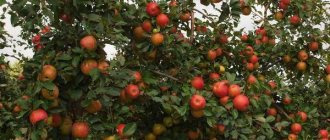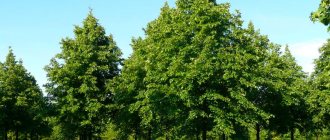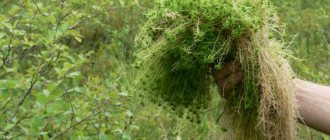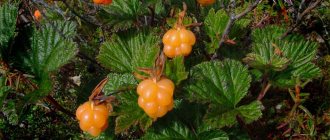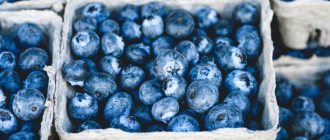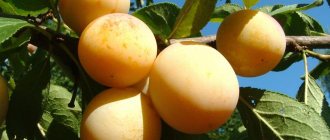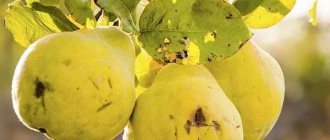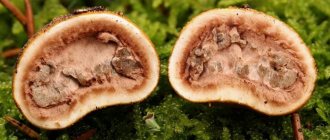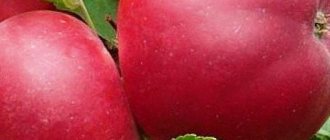Winter apple trees with sweet fruits are rarely found in northern gardens.
It is believed that the sweet taste is the difference between southern and summer varieties.
The Belarusian sweet variety breaks stereotypes. These are real winter apples that are stored until February , and they have absolutely no sourness.
The Belarusian Sweet apple tree variety is gaining popularity among professionals and amateur gardeners.
IMPORTANT! To obtain consistently high yields, you should take into account the features of planting, caring for a young apple tree, pruning and harvesting.
Description
The Belarusian sweet apple tree is a fast-growing winter variety .
Bred by breeders of the Institute of Fruit Growing of the Republic of Belarus about 20 years ago. Registration in the State Register took place in Belarus and Russia in 2005 and 2006, respectively.
In Russia it is zoned for the Central region:
- The tree is medium-sized , fast growing, reaching a maximum height of 3 m by 8-9 years after planting.
- The crown is sparse, round or round-conical, with slightly drooping branches.
- The fruits are large, average weight 160-180 g. Round, sometimes asymmetrical. The skin is smooth, greenish-yellow, turning yellow when it reaches full maturity.
- The outer color in the form of a blurred blush occupies almost the entire surface of the fruit.
- The pulp is very light, without a pronounced shade. Coarse-grained, semi-oily, medium density, tender, sweet, with a light aroma.
Harvesting maturity occurs in September ; in warm regions it can last until October.
Consumer maturity - from October to February under favorable ripening conditions, in other cases it is reduced to December - January.
Recommended for growing in industrial and personal gardens. The purpose of the variety is universal.
Description and characteristics of the Antonovka variety
At the moment, it is not known exactly who and when the Antonovka variety was bred. Therefore, it belongs to folk selection. Its varieties include varieties such as Zolotaya, Imbrus, Bogatyr, Dessertnaya, Shestisotgramovaya, Funtovka, Cherry, Seraya, Belaya, Obyknovennaya, etc.
Important! Apple varieties grafted on Antonovka develop and bear fruit better than those on wild apple trees.
Main characteristics of the Antonovka variety:
- late autumn or early winter ripening;
- trees are strong, tall (on average up to 7 m) with a round or oval crown;
- skeletal branches stretch upward, where they later branch;
- leaves are rich green, rounded with short petioles;
- flowers of pale pink color, densely covering tree branches;
- apples are large, round, yellow, smooth, hold tightly to the branches, average weight 150 g;
- the pulp is white, sweet and sour in taste, juicy;
- begins to bear fruit at 6–7 years of age;
- has a pronounced odor;
- 100 g of product contains 44 kcal, 0.3 g of protein, 0 g of fat, 10 g of carbohydrates, 0.5 g of dietary fiber, as well as vitamin C, potassium, magnesium, iron, phosphorus, etc.
Advantages and disadvantages
- The advantages of Antonovka include:
- long-term preservation of apples;
- fruits are rich in vitamins and minerals;
- universal use: jams, compotes, juices are prepared from it, used in pickled form, etc.;
- long fruiting (30–40 years);
- frost-resistant;
- well developed root system;
- used for breeding other varieties of apples;
- high productivity;
- not susceptible to scab;
- They are used not only in cooking, but also in medicine.
- The disadvantages are:
- average resistance to powdery mildew and fruit rot;
- old trees bear fruit irregularly.
Pollinators
The Antonovka apple tree is a self-fertile variety that requires pollinators.
Pollinator plants must meet the following requirements:
- the period of flowering and ripening must coincide;
- pollinators must produce high-quality pollen annually;
- lack of mutual cross-sterility.
Productivity
Antonovka produces its first significant harvest 5–7 years after the seedling is planted in the ground. It bears fruit annually for the next few years. Older trees produce up to 200 kg of apples per tree, but not every year. Gardeners received a maximum yield of more than 500 kg from 1 tree.
Transportability
Considering that Antonovka is an early winter variety, apples harvested in September or October are highly transportable, provided they are properly packaged.
It is as follows:
- Only apples picked from the tree are suitable for transportation, since when shaken they are damaged and begin to rot faster;
- Fruits need to be picked a little earlier, before reaching technical maturity;
- special containers for transportation must be disinfected and thoroughly dried;
- The apples in the container must be placed in such a way as to avoid the fruits hitting each other.
Frost resistance
One of the main favorable features of the described variety is its resistance to low temperatures, thanks to which Antonovka can be grown in regions with very cold climates. Research by scientists on the physiology of resistance at VNIISPK has shown that plants can withstand frosts down to -40°C.
Did you know? In Manhattan, the apple tree planted in 1647 by the American Peter Stuyvesant still grows and bears fruit.
But this applies to mature trees. Young trees are not so hardy. and in the first years after planting, it is advisable to insulate them for the winter. For this purpose, mulching of the tree trunk circle and covering material are used.
Advantages and disadvantages
advantages of the apple tree are noted :
- Precociousness;
- Regular fruiting;
- Frost resistance;
- Excellent resistance to scab and very good resistance to bark and wood cancer;
- High taste and commercial-economic qualities;
- The fruits hold tightly to the branches and do not fall off;
- Good storage capacity.
The disadvantages are relative:
- Possible reduction in shelf life;
- Not everyone likes the completely sweet taste
Tree height
In the first 7-9 years after planting a seedling, the tree grows up to three meters or slightly higher.
Crown width
The crown is compact, up to 2.5-3 m in diameter.
Productivity
Fruiting of the Belarusian sweet apple tree.
Productivity is consistently high, without periodicity. It grows quickly, reaching 30-35 kg per tree by 5 years. The potential of industrial gardens is estimated at 300 centners per hectare or more .
Self-fertility
The variety is self-fertile; pollinator varieties are not required.
Tasting assessment
Apples are very sweet, with a delicate taste and aroma.
Professional experts disagree on the tasting assessment:
- The first rate the taste at 4.1,
- The second ones are 5.0 out of 5.
Gardeners are inclined to the second opinion , considering the sweet taste of this apple to be far from bland, although lacking sourness.
Lovers of sweet fruits consider Belarusian sweet to be the best among its kind.
Winter hardiness
is noted for its good winter hardiness , making it suitable for cultivation in regions with fairly harsh winters. Apple trees can withstand frosts down to minus 36.
ATTENTION! Gardeners have not yet made observations regarding colder winters, and also have not had the opportunity to assess the tree’s ability to recover in the event of frostbite.
Disease resistance
The advantage of the Belarusian sweet is absolute immunity to scab, resistance to damage to bark and wood.
Lifespan of a tree
In favorable conditions, the apple tree bears fruit for 25-30 years, on weak-growing rootstocks - 15-20.
Apple tree Belarusian sweet: secrets of cultivation
The variety “Belarusian Sweet” was created by breeding scientists from the Belarusian Research Institute of Fruit Growing Grakovich, Evdokimenko, Kovalenko and Marudo.
Medium-sized apple trees grow quite quickly - by the 8th year of living in the garden they reach up to 3 meters in height. The crown is not particularly dense, round in shape, somewhat cone-shaped and slightly drooping. This shape makes tree care and harvesting easier.
Apples of the “Belarusian Sweet” variety are usually medium or large in size, weighing from 140 to 200 grams. They are round, smooth, very pretty, so they will decorate not only the tree, but also your dining table.
The skin of apples is green-yellow, turning yellow when ripe. However, yellowness rarely shows through a solid red blush. The pulp of the fruits of the “Belarusskoe Sweet” variety is white, not very dense, but at the same time extremely tender.
The taste is sweet, without sourness, the aroma is weak but persistent.
For 100 grams of apple pulp there is:
- 12% dry matter;
- 9.5% sugar;
- 0.2% titrated acids;
- 11 mg ascorbic acid;
- 1113 mg P-active substances.
The apple fruits of this variety ripen in mid-November, but sometimes ripening occurs earlier, approximately in mid-to-late October.
Characteristic
“Belarusian sweet” exhibits high frost resistance, surviving temperatures down to -36 °C without critical losses. This is combined with high productivity and early fruiting. Already in the 5th year of growth, the apple tree produces up to 35 kilograms of apples per tree. It should also be noted that the variety is highly immune to scab, which allows it to be grown without fear for the size and quality of the harvest.
The big advantage of this variety is that when ripe the apples do not fall off the branches. However, if you keep them on wood, their shelf life is significantly reduced. So, if harvested in a timely manner, they can be stored until February, if harvested late, only until mid-December.
Interestingly, using clonal rootstocks (for example, 54-118 or 5-25-3) you can speed up fruiting. If an ungrafted tree bears fruit in 2-3 years of life, then with a clonal rootstock it produces a harvest already in the first year of growth. Considering that the variety bears fruit at the same level every year, this is a good way to get tasty apples without a long wait.
Disease and pest control
As already noted, the variety is well resistant to scab, but this does not mean that preventive treatments with special preparations are not necessary. By increasing the tree's immunity, you only strengthen it. Thus, for comprehensive prevention of diseases caused by fungal spores, in the spring it is necessary to spray trees with complex action fungicides, such as “Fitosporin”, “Topaz”.
To prevent the development of colonies of harmful insects, you can use a hoop trap made of corrugated paper. It is also recommended to treat trees and the soil around trees with insecticides such as Karbofos or with Ecoberin and Zircon preparations.
Reviews
Despite its short history, the variety has earned the recognition and sympathy of gardeners. Here's the feedback they share.
Alexander: I grow Belarusian sweets in the Yaroslavl region. I bought it after reading the description and photo. Fruiting since 2014. I'm forming it with a tree for now; it has overwintered well for several winters. Not sick. The apples don't fall off and hold up well. I'm filming at the end of September. Beautiful, sweet. The taste is very interesting, this makes it different from other sweet varieties .
Ekaterina: I collect it when the first fruits fall to the ground. I think this is the best time for ripeness and sugar content. Here in Minsk it is the end of September. I store them in a regular basement and they remain spotless until the New Year . Probably, if you remove them earlier, when they are greener, they will be stored longer.
Igor: Belarusian sweet is a world-class apple tree! Only advantages! I purchased it because... I came across a photo and description of the variety and decided to check it out. It turned out to be very tasty, a special taste and aroma that distinguishes this apple from others.
Doesn't fall off. Doesn't get boring. Stores perfectly. You can eat it straight from the tree . Beautiful. For some reason ours are different sizes, and this is the only drawback.
Harvest and storage
They begin to collect at the end of September, when they are fully ripe. The fruits rarely fall, but you shouldn’t delay picking them. After all, in wet weather they often begin to rot.
They pick the apples with their hands, along with the stalks. The wax coating cannot be washed off; it ensures long-term storage.
After harvesting, the fruits are placed in boxes, lined with dry grass, straw, special shavings or paper. After this, the boxes are immediately sent for storage.
They retain their qualities best at a temperature of 1-5⁰С. Such conditions can be provided in the refrigerator or basement.
Keeping quality is good. The products are stored until the beginning of May next year. Taste qualities only improve during storage. The apple becomes sweeter and more aromatic, the pulp acquires an oily texture.
Some of the fruits are sent for processing. Juices are pressed from them, jams and marmalades are made, and compotes are made. But most gardeners prefer to eat apples fresh. At the end of winter and spring they can be sold profitably. After all, at this time the prices for fruits are very high.
Features of planting and care
Knowledge of the peculiarities of planting and caring for the Belarusian sweet apple tree will be useful for growing a healthy, long-term tree and obtaining regular impressive harvests.
Apple tree seedlings of the Belorusskoe sweet variety.
Landing
Deadlines
Seedlings are planted in early autumn 3-4 weeks before the onset of frost or in early spring, when the ground has already thawed and sap flow in the tree has not yet begun and the buds have not swollen.
Technology
A spacious pit for planting is prepared in advance, 1-2 weeks in advance. Its size is 1 m x 1 m, depth is at least 0.7 - 0.8 m.
Middle fraction gravel or vermiculite is placed at the bottom.
Then add rotted manure, complex mineral fertilizer, wood ash, and mix everything.
Fill in some of the fertile soil removed from the hole so that the mound is higher than half the depth.
A stake is installed in the center, to which the seedling is tied after planting. Place the tree on the mound, straighten the roots, and cover it with clean, fertilizer-free soil.
IMPORTANT! Care should be taken that the seedling is located on a mound, and the grafting site rises 10-15 cm above ground level.
The soil around the tree is compacted. The tree trunk circle is framed with a roller of earth. Water with two to three buckets of water.
On semi-dwarf rootstocks they are planted according to a 5x3 meter pattern, on dwarf rootstocks - 4x2 meters.
important conditions for planting :
- You should choose an area that is open, but without drafts, well lit by the sun;
- Fertile, loamy, well-drained, breathable soil is preferred;
- The grafting site after the soil shrinks should remain high above the ground so that the scion does not take root on its own, bypassing the rootstock (this will lead to the loss of the qualities of the rootstock, for the sake of which the grafting is carried out).
Caring for seedlings in the first year
Apple trees in the first year of life need special attention and a little more intensive care:
- During the growing season, the tree should be watered generously every month, and in dry times - once every 2-3 weeks.
- First-year children need to be protected from cold winds ; in the future such measures will not be needed.
- On the eve of the first winters, it is useful to cover the trunk with spruce branches, tying it with the tops down. You can also use reed, parchment, rags. This will protect the seedling from frost and rodents.
- Mulching the tree trunk space helps to structure the soil, retain moisture, and provide air saturation. Forms additional protection from cold and supplies nutrients with organic substances.
Agricultural technology
set of agrotechnical practices for an adult apple tree :
- Watering 3 – 4 times per season;
- Two - three times feeding;
- Regular loosening and weeding;
- Mulching;
- Formative and sanitary pruning;
- Preventing diseases and maintaining immunity.
For high-yielding varieties, such as Belarusian Sweet, timely fertilizing with mineral and organic fertilizers is important to maintain the viability of the tree and regular fruiting:
- In spring - nitrogen and liquid organic;
- After flowering - a mineral complex, including nitrogen, potassium, calcium components;
- In the fall - phosphorus and potassium, they will help prepare the apple tree for winter, strengthen the immune system and frost resistance.
Pruning and crown formation
The formation of the crown of an apple tree in the form of pruning is required for fruit plantings almost throughout the entire life of the plant.
In early spring , before the buds wake up, sanitary and formative pruning is carried out:
- Remove weakened, damaged, dried and frostbitten branches.
- Trim off excess shoots that thicken the crown.
- Get rid of branches that grow vertically along the trunk or inside the crown.
Taking into account the high growth rates of Belarusian sweets, the annual growth is cut by about one third.
Annual apple trees
ATTENTION! A seedling purchased from a nursery usually has several correctly located main lateral (skeletal) branches. In this case, there is no need to prune during planting.
After the first wintering, you should begin to form the crown of a young apple tree. During this time, abundant growth appears, which should be removed:
- The central conductor is shortened by 20%, leaving about 40 cm above the upper skeletal branch.
- The side branches are shortened by one third of the growth, while the top ones should be shorter than the bottom ones.
- To check the correctness of pruning, the branches are simultaneously pulled towards the trunk: the tops should be at the same height, while the vertical shoots remain 20-25 cm higher.
Pollinator varieties
The variety is self-fertile, no special pollinators are required.
How to plant an apple tree
The holes for seedlings are prepared two weeks before planting, during which time the soil settles well. They dig them with a diameter of 1.2 m, a depth of 50-60 cm, separating the more fertile top layer, which will later be used for planting.
The dug hole is further processed. To do this, use a metal rod or shovel to loosen the bottom to a depth of bayonet height. Old tin cans, walnut shells or rusty iron are placed there, and then sprinkled with 20 cm of previously removed top soil. Fertilizers and a little wood ash are also added to the prepared pit. All this is very useful for the Belarusian Sweet tree. The apple tree variety is susceptible to fertilizing, so the result will not take long to arrive. Fertilizers are mixed with the soil, adding soil from the top layer of soil. In total, the hole should be filled to half its volume. Fertile soil is also added to the remaining part of the hole until a mound 20 cm high rises. This rule cannot be neglected, otherwise the seedling will sag. A stake is driven into the center of the formed hill - the future support for the seedling. After this, the seedling is installed, its roots are straightened and covered with fertile soil, carefully compacting it.
Since the “Belarusian Sweet” apple tree requires special nuances when planting, it is better to involve household members, neighbors or a gardener friend to help. It is imperative to tie the seedling to a driven stake in order to provide it with reliable support.
Features of ripening and fruiting
Beginning of fruiting
The variety is early fruiting . The first apples appear in 2-3 years, on clonal rootstock often in the first year after planting.
Flowering period
Flowering in May, the exact dates and duration depend on the region of growth and weather conditions of the area.
Deadlines
Fruit ripening
Standard ripening dates are September - early October . But the dates also depend on the climate: in more northern regions, harvesting maturity occurs at the end of August.
You can eat apples immediately after picking, although experts indicate the period of consumer maturity: January - February.
Fruit storage
In a dark, cool room, the fruits are stored from October to February. The period may be shortened to December, depending on growing season conditions and timely harvesting of fruits .
General characteristics
The Belarusian land has always been famous for its fertility; a variety of garden and berry crops are grown, and fruiting is usually excellent. Breeders from local research institutes have developed varieties of apple trees specifically for their lands, with different ripening periods and a wide range of tastes.
The main criteria for varieties were:
- Good frost resistance;
- Increased immunity to various fungal diseases, scab in particular;
- Large fruit size;
- Good taste of the resulting harvest.
The varieties will also differ in the size of the mature tree: in order to speed up the onset of fruiting, apple trees are grown on dwarf and columnar rootstocks.
Interesting! The crown of such a tree will be small, this will greatly simplify harvesting.
There are many varieties suitable for cultivation in Belarus, but there are a couple of dozen main varieties that are most common throughout the country.
Growing in regions
Very productive winter variety Belorusskoe sweet.
The Moscow region has the most favorable conditions for the Belarusian sweet apple tree, because the climate is similar to Belarusian. The variety is zoned for this region.
In the Urals , in the absence of extreme cold and with proper care, enthusiastic gardeners get good results in growing this winter-hardy variety. The fruits are harvested in early September. Observations of the variety in harsh conditions continue.
In Ukraine, the climate is milder and closer in characteristics to the Belarusian weather; the apple tree feels quite comfortable here.
The best varieties of apple trees in Belarus
Belarusian varieties of apple trees are practically universal, adapt well to various conditions and are distinguished by their taste and ripening time. Among them are summer, autumn and winter, tall and dwarf.
Their special properties are large fruits with excellent taste, and the trees’ resistance to severe frosts. And also the varieties of Belarusian selection are distinguished by good immunity to fungal diseases, including scab.
Summer
Representatives of summer apple tree varieties in Belarus are distinguished by their early ripening. They are removed from trees in the second half of summer. Most of them do not have a long shelf life, but under the right conditions they can last a month or so.
Kovalenkovskoe
Late summer variety with excellent taste characteristics. The fruits are very tasty, sweet, large in size, practically without sourness. Their main color is green, but ripe fruits become beautiful red, ruddy and glossy. The difference between this variety and other summer representatives is that they are not removed from the tree at the moment of consumer maturity, but become so after a week.
Apple tree Kovalenkovskoe.
The tree is medium-sized, with a beautiful rounded crown that grows densely. The leaves are small, oval, green. A representative of this variety blooms early, the flowers are large, fragrant, and white.
Robin
A representative of the variety can get along well where severe frosts attack. However, it is afraid of excess moisture, and in the rainy season it can suffer from rot and scab. The growth of the tree is average, with a dense spherical crown, the branches grow slightly upward.
Apple tree Malinovka.
The fruits are medium-sized, round with small ribs. Their hue is yellow-green with red uneven strokes. The pulp is sweet and sour, juicy, fine-grained with light veins.
Radiant
This variety is distinguished by its amazing resistance to extreme cold. And also it is not afraid of high humidity, does not suffer from rot and scab. The tree itself is compact in size, with a neat crown. Most often it is grown on dwarf and medium-sized rootstocks. Productivity is high.
Radiant apple tree.
The fruits are medium in size and have a pleasant sweet and sour taste in ideal proportions. Their appearance is very impressive, they are yellow-green in color, with orange-red ruddy sides. They are removed in September and can be stored for a maximum of two months.
Belarusian sweet
A representative of this Belarusian apple variety has medium height, a sparse crown with drooping branches. The tree is distinguished by early fruiting and resistance to frost and fungal diseases.
Apple tree Belarusian sweet.
The fruits are large in size, round with slight asymmetry. Their hue is yellow-green, and as they mature they acquire a red blush. The soft flesh is juicy, tender and soft, very sweet.
Minsk
The guest from the capital of Belarus is distinguished by its average crown size, beautiful, rounded shape. The fruits ripen abundantly every year and are harvested in early September. The tree is resistant to frost and rot, of medium grade with a beautiful rounded crown.
Apple tree Minsk.
The fruits are quite large, almost all the same. They have the correct shape, a neat rounded cone. A green apple turns yellow as it grows, and a beautiful reddish blush appears on it. It keeps very well until the New Year. The taste of apples is sweet and sour, the flesh is aromatic, dense and medium-grained.
Elena
This is a hybrid apple variety that has many advantages. It is quite early-growing and produces a large number of fruits. However, if there are too many apples on the branches, they become smaller. The growth of the tree is average, the crown is medium dense, pyramidal.
Apple tree Elena.
The fruits are medium-sized and even smaller than average, round, slightly flattened. Their shade is green, half covered with a red blush. Taste qualities, if measured on a generally accepted scale, are rated at 4.8 points. However, many believe that this figure is significantly overestimated. They are juicy, sweet, but slightly bland.
Champion
This variety is probably one of the most common. It is loved for its very bright taste. They are large in size, regular in shape, green with a faint blush. The aroma is very bright and persistent. The pulp is dense and juicy. The fruits have a universal purpose and last a long time, and can be transported well.
Apple tree Champion.
A medium-sized tree with a compact crown. It bears fruit annually and abundantly. However, severe frosts can damage tree roots. With excess moisture, rot and scab attack it.
Spartan
A high-yielding variety of apples that bears fruit quickly and amicably. However, a tree of short stature may suffer from severe frost and is susceptible to rot and fungi. The crown grows abundantly, quickly, and becomes thickened if left without proper care.
Apple tree Spartan.
The fruits are round in shape, with a yellow-green tint to the surface and a blush that almost completely covers the entire area. The skin is covered with a coating, its hue is raspberry-violet. The pulp is dense, juicy and sweet, with a persistent aroma. Apples acquire their richest flavor at the beginning of winter and are stored until spring.
Geneva
The tall tree has a wide, oval crown. It gives a bountiful harvest every year, starting from the fifth. The roots freeze at temperatures below – 20 degrees. Under conditions of high humidity, branches may suffer from scab, so the use of fungicidal preparations is an important condition for tree care.
Apple tree Geneva.
The fruits are large, beautiful, red-burgundy in color. The harvest takes place in early September, but the fruits ripen unevenly and are not stored at all. They are consumed immediately fresh or processed.
Winter
Winter varieties of Belarusian apples produce their fruits at the same time, but they are harvested in the fall, and they acquire their maturity and true taste closer to winter. These vitamin charges will nourish even until spring, if stored correctly. Here are some of the best winter apple varieties for Belarus.
Honey Crisp
A late variety of apples, characterized by high growth rates. The tree is medium-sized, rarely growing more than 4 meters tall. The crown is pyramidal when young, but becomes oval as the tree grows. Particular advantages of the variety are resistance to fungal diseases and low temperatures.
Apple tree Honey Crisp.
The apples sit on the branches abundantly and thickly, set and ripen together. The first fruits can be harvested 4 years after planting. They are large in size, cone-shaped, and have a beautiful yellow-red hue. Their pulp is very pleasant to the taste, sweet with a slight sourness. They are stored for a long time and can be successfully transported, even over long distances.
Navavita
A representative of this Belarusian variety is distinguished by early, but extremely abundant, regular fruiting. The tree has good immunity to scab and other fungal diseases; they are not afraid of low temperatures. The crown is spreading and thickens without proper formation.
Navavit apple tree.
The fruits are usually collected from the branches in September or even early October. They are stored in good conditions for about 5 months. They are flat-round in shape, green in color with light burgundy sides. The dense pulp is sweet and sour, very harmonious in taste.
Belana
One of the young varieties of Belarusian selection, which has already been appreciated by many gardeners. It is especially valued for its strong immunity to scab and other particularly dangerous diseases. The tree has a medium-sized spreading crown.
Belan apple tree.
The fruits appear already in the third year, fruiting becomes abundant and regular. Apples are picked in September and stored until early spring. They are quite large, flat-round, yellow-green with a blush. The taste is very harmonious, with an ideal proportion of acid and sweetness, there is practically no aroma.
Antey
Small trees have absorbed all the best qualities of apple trees. They are considered unpretentious, with a small crown, resistant to severe frosts, produce a large number of fruits that are stored for a long time, and can be transported over long distances. The disadvantage is susceptibility to rot and scab.
Apple tree Antey.
The fruits are large in size, collected from the tree in September, but are perfectly stored until the end of spring. They have the correct shape and beautiful colors: the main color is green, and the blush is burgundy or reddish. The pulp has a green tint, sweet and sour.
Auxis
The tree, a representative of this variety, is of medium height, neat and compact. It can survive a slight frost, but in extreme cold the roots suffer. Fungal diseases will require protection in the form of fungicidal drugs.
Apple tree Auxis.
The apples are medium-sized, greenish-yellow, but almost completely covered with a red blush. Their taste is also distinctive. The pulp is sweet with a slight appropriate sourness, juicy, and leaves a pleasant spicy aftertaste.
Lobo
Although this variety comes from Canada, it is successfully planted in Belarus, even on an industrial scale. A medium-sized tree with a rounded crown of regular shape. It is particularly resistant to low temperatures.
Apple tree Lobo.
The fruits are large, very beautiful, stored for a very long time and have a good presentation, which is not lost during storage and transportation. The apple is raspberry in color, with a yellow tint visible here and there. They are distinguished by a pleasant taste, sweet with a slight sourness, caramel flavor and persistent aroma.
Zaslavskoye
The tree of this variety produces fruits in mid-September. It is characterized by almost perfect resistance to severe frosts and good immunity to common diseases.
Apple tree Zaslavskoe.
The fruits are cone-shaped and sometimes have ribs on them. They are large in size, dark green in color, but almost completely covered with a dark red blush. The taste of the pulp is very fresh, light, sweet and sour. The aroma is light, subtle, and becomes more noticeable over time. Apples keep very well until the very beginning of March.
Koshtelya
Trees of this variety are distinguished by their abundant and long fruiting, but it is cyclical. They are resistant to frost and fungi, which is why they have gained great popularity. The crown is neat, sparse, rounded.
Kostel's apple tree.
Apples are picked green and stored until the end of winter, acquiring a persistent aroma and pleasant taste over time. The sweet and sour taste is not particularly clear to some, but the aftertaste will not leave anyone indifferent.
Idared
It seems that there are no gardeners and lovers of delicious fruits who have not heard of this variety. It is grown on an industrial scale and is valued for its amazing transportability and beautiful appearance, which does not deteriorate at all over time. The taste of the fruit is harmonious, sweet and sour. They are used both for preparing desserts and for fresh consumption.
Apple tree Idared.
Rating of varieties
In order for the garden you plant to develop and bear fruit regularly, you need to carefully consider the choice of varieties. Particular attention is paid to:
- on pollinating varieties that will grow in the neighborhood. To do this, similar trunks with the same or different ripening periods are selected;
Advice! “Raika” will be a universal pollinator for any apple tree.
- The soil in which the seedlings will be planted will also be important. Each variety has its own characteristics and preferences for soils, it is worth taking this into account;
- Fertilizers and plant feeding should be carried out regularly;
- do not forget to clear and trim the crown.
These are universal tips for all standard trees, but for the lands of Belarus it is worth choosing seedlings for planting:
- with good frost resistance, because often the thermometer shows low temperatures, which can simply destroy established flower beds;
- having immunity to scab and other fungal diseases that can negate your care efforts;
- regular yield is desirable, then the gardener will have fruits every year;
- choose varieties on a dwarf or columnar rootstock, this will significantly speed up the fruiting period;
- Drought resistance is also important, because in hot weather it is not always possible to water the trees.
Apple tree seedlings with a closed root system.
These characteristics are inherent in many varieties of both domestic and foreign selection, which take root well and bear fruit.
One has only to study in more detail the characteristics of a particular variety and take full responsibility for caring for the seedling.
By sweetness
You can choose seedlings according to individual taste preferences. Lovers of sweet apples will enjoy:
- Kovalenkovskoe;
- Belarusian sweet;
- Spartan;
- Honey Crisp.
According to scab resistance
Abundant fruiting also depends on the tree’s immunity; the higher it is in relation to scab and other fungi, the greater the yields will be. These diseases are not scary:
- Radiant;
- Belarusian sweet;
- Minsky;
- Elena;
- To the champion;
- Spartan;
- Belane;
- Zaslavsky;
- Koshtele.
Apple scab.
According to ripening time
Autumn
The timing of fruit ripening is also important; in early autumn you can consume:
- Melbu;
- Elena;
- Radiant;
- Kovalenkovskoe;
- Malinovka;
- Geneva;
- Belarusian sweet.
Winter
In cold weather, apples will help remind you of summer:
- Honey Crisp;
- Navavita;
- Belana;
- Antey;
- Auxis;
- Lobo;
- Zaslavskoe.
Dwarf, stunted and columnar trunks
In order to save space on the plot and plant more different varieties, gardeners are increasingly giving preference to compact apple trees.
On a dwarf rootstock you can grow:
- Idared;
- Geneva;
- Champion.
It is better to make it columnar:
- Malinovka;
- Kovalenkovskoe;
- Radiant.
Low stature is distinguished by:
- Lobo;
- Belarusian sweet;
- Honey Crisp.
Features of Belarusian selection
In Belarus, back in Soviet times, a lot of breeding work was carried out, which does not stop to this day; Belarusian varieties are known to gardeners from different countries. Of the new ones, I would like to name the following early or summer varieties: Kovalenkovskoe, Orlovim, Mechta. They ripen in July and can only be stored for one month. The following autumn varieties, zoned for the Vitebsk region, are well known to professionals: Luchezarnoye, Orlik, Auksis.
Autumn apples are good because they ripen at the beginning of autumn; you can eat them for up to three months without losing the quality of the fruit. But winter varieties are considered the real elite of the apple crop; they produce a harvest in early autumn and store it for about five months. The latest technical ripeness comes in October, and it is recommended to eat them after a couple of months, when the sweetness and aroma intensify, they can be stored until the new harvest.
Among them, columnar apple trees occupy an important place, and among the local ones, Alesya, Freedom, Pamyat Kovalenko, Verbnoye, Pospeh, Zaslavskoye, Antey, and Belorusskoye Raspberry received excellent reviews. The varieties of their apple trees are well known in Belarus; for many of them, the Golden Delicious apple tree served as the breeding material. Before deciding which apple trees to plant in your garden, you should look at reviews, read the descriptions and main characteristics of the varieties, including columnar apple trees.
